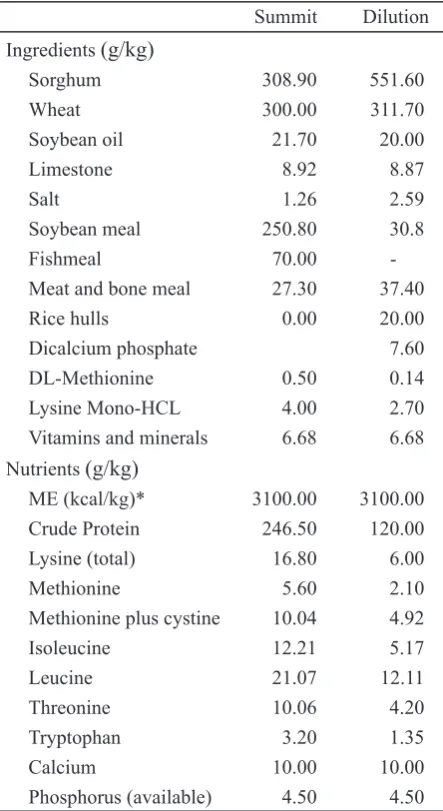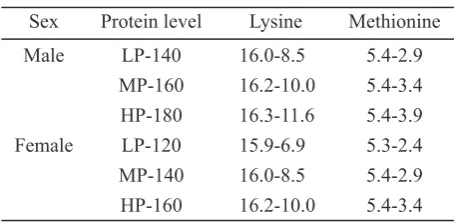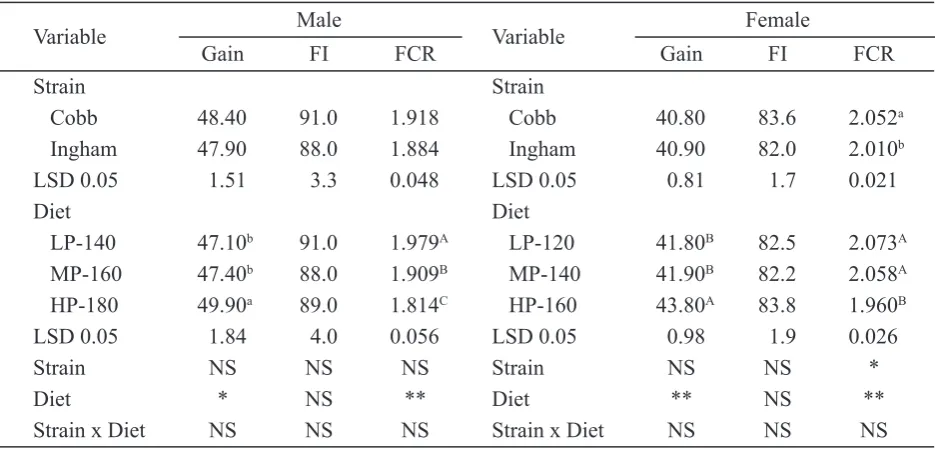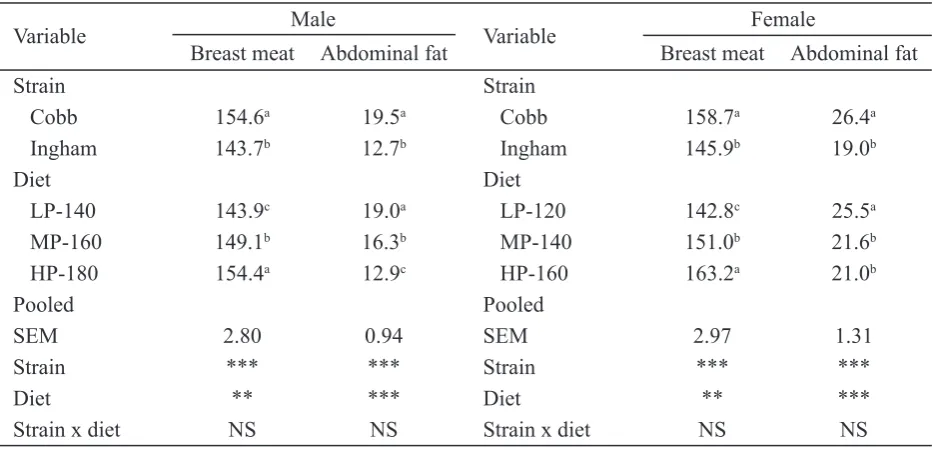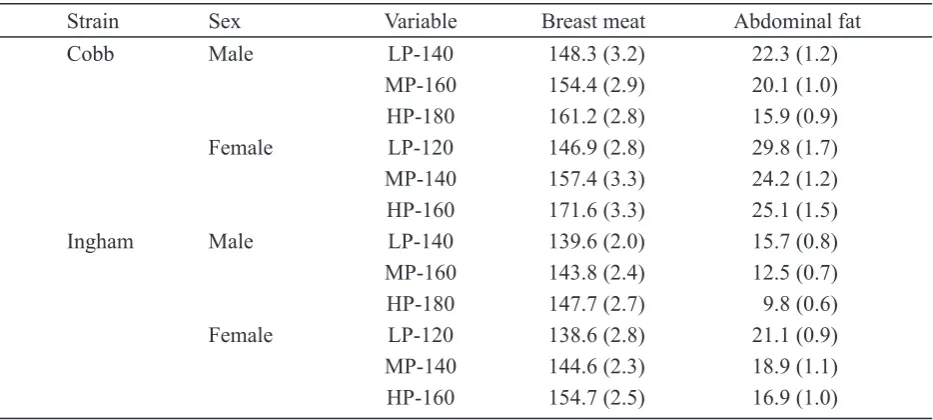Response of Two Different Strains of Commercial Broilers to Different
Dietary Amino Acid Allowance
B. Indarsih*
Jurusan Produksi Ternak, Fakultas Peternakan, Universitas Mataram Jln. Majapahit No. 62 Mataram Lombok Nusa Tenggara Barat
(Diterima 23-02-2009; disetujui 03-06-2009)
ABSTRACT
The response of Cobb and Ingham strain commercial broilers to a range of dietary amino acids in a factorial experiment (2 strains x 2 sexes x 3 dietary treatments) with 3 replicates was evaluated. A total of 180 birds was sexed and weighed at one-day-old and randomly distributed to 36 brooders. Summit (246 g CP and 16.8 g lysine/kg) and dilution (120 g CP and 6.0 g lysine/kg) diets were prepared in isocaloric at 3100 kcal ME/kg. The estimated dietary level of crude protein for all birds at day-old was 240 g/kg and at 42 days were 120, 140 or 160 g/kg for females or 140, 160 or 180 g/kg for males. Body composition was measured at 42 days. Results revealed that strain Cobb males and females had a higher daily intake than Ingham, but Cobb females were less effi cient in converting feed to weight gain than that of Ingham. The quantitative differences did not exist between genotypes, crude protein and lysine. Daily gain and feed utilization effi ciency in both sexes were highest in group receiving the high protein diet. Lysine requirement was 14.58 g lysine /kg diet and 12.96 g/kg higher than NRC recommendation (1.05 % or 10.5 g/kg) for maximum breast meat and lowest abdominal fat.
Key words: lysine, summit, dilution, breast meat, abdominal fat
of broilers have also been observed for many years (Ten Doeschate et al., l993; Sterling et al., 2006). The most limiting amino acid requirement particularly lysine in different strains has been shown to be greater for maxi-mal feed effi ciency than for maximal growth (Fatufe et al., 2004; Sterling et al., 2006). NRC (1994) requirement for lysine for broilers 3-6 wk of age is 1.00% total. Reported by Dirain & Waldroup (2002) that increasing lysine levels from 1.03% to 1.12% signifi cantly (P<0.05) improved breast yield (BY) and reduced abdominal fat. Although estimated requirement for limiting amino acids vary, it is agreed that requirement for growth is less than
*Korespondensi:
Jurusan Produksi Ternak, Fakultas Peternakan, Universitas Mataram
Jln. Majapahit No. 62 Mataram Lombok Nusa Tenggara Barat E-mail: [email protected]
Terakreditasi B SK Dikti No: 43/DIKTI/Kep/2008
INTRODUCTION
that for feed conversion and meat yield. In addition, increase in the levels of these amino acids individually or in combination with other factors (crude protein, essential amino acids, and energy) results in better growth and meat yield (de Leon, 2006).
When supply of essential amino acids is limiting but dietary energy concentration is high, the feed consumption is an increase in an attempt to satisfy essential amino acid (EAA) requirement (Koch et al, 2002; Oviedo-Rondón & Waldroup, 2002. Dirain & Waldroup, 2002; de Leon, 2006). In this circumstance, intake is largely regulated by EAA requirement and growth is limited by amino acid intake. In commercial practice, formulating diets to fulfi l minimums amino acid is critical to optimize live production and breast meat yield of broiler chicken. Therefore, this study was undertaken to evaluate the growth response of two dif-ferent commercial broiler genotypes (Cobb and Ingham) to a range of dietary amino acid regimens.
MATERIALS AND METHODS
Birds and Experimental Procedure
Cobb and Ingham (n=90 per genotype) broiler chicks of commercial strains were randomized and reared in 36 bamboo brooder cage of 1.0 m x 1.0 m each to investigate the response in growth and body composition to a range of dietary amino acid regimens. The chicken were sexed and weighed at one day old and alocated in to 3 dietary treatments with 3 replicates of 5 birds each. Each cage was equipped with one drinker and 1 circular tube feeder. Temperature of the experimental house was maintained at about 32 °C for week 1, 29 °C for week 2, 26 °C for week 3, and 22 °C thereafter. Birds and feed were weighed on a weekly basis. At 42 days of age, all samples of 5 birds from each dietary treatment were slaughtered for measurement of body com-position. Breast meat and abdominal fat were removed and weighed.
Dietary Treatments and Feeding Programs
A summit-dilution approach was used in many of the studies in diet formulation to examine the growth and body composition responses of different genotypes to variation in dietary amino acid concentration (Gous & Morris, l985; Surisdiarto & Farrell, l991; Huyghebaert & Pack, l996; Plumstead et al., 2007). The summit diet was formulated to contain a large excess of assume requirement of all indispensable amino acids except the one
Table 1. Ingredient and determined nutrient com-position of the summit and dilution diets used in this experiment
Summit Dilution
Ingredients (g/kg)
Sorghum 308.90 551.60
Wheat 300.00 311.70
Soybean oil 21.70 20.00
Limestone 8.92 8.87
Salt 1.26 2.59
Soybean meal 250.80 30.8
Fishmeal 70.00
-Meat and bone meal 27.30 37.40
Rice hulls 0.00 20.00
Dicalcium phosphate 7.60
DL-Methionine 0.50 0.14
Lysine Mono-HCL 4.00 2.70
Vitamins and minerals 6.68 6.68 Nutrients (g/kg)
ME (kcal/kg)* 3100.00 3100.00
Crude Protein 246.50 120.00
Lysine (total) 16.80 6.00
Methionine 5.60 2.10
Methionine plus cystine 10.04 4.92
Isoleucine 12.21 5.17
Leucine 21.07 12.11
Threonine 10.06 4.20
Tryptophan 3.20 1.35
Calcium 10.00 10.00
Phosphorus (available) 4.50 4.50
RESULTS AND DISCUSSION
Growth Responses
The fi rst step in evaluating an amino acid requirement is to develop a diet that is limiting only in the amino acid that is of interest. The experimental diets here were clearly not defi cient in lysine as indicated by the not signifi cant responses on feed intake for both sexes and strains (Table 3). Birds fed the diet containing protein 140 g/kg at 42 days (low protein diet) and 160 g/kg (medium protein diet) had body weight gain (47.1 g/bird/day and 47.4 g/bird/day) and feed/gain ratio (1.979 and 1.909) that were lower than responses of body weight gain (49.9 g/bird/day) and feed/ gain ratio (1.814) of birds receiving 180 g/kg (high protein diet) in males. Similar trend was also shown in females.
Lysine and methionine intake increased on low dietary protein and decreased on high dietary protein (Table 4). Thus, feed intake was regulated by amino acid requirement. Therefore, improvement in body weight gain and feed/gain ratio can be made on a dietary amino acids with a high density.
In regard to feed intake, Cobb males and females had a higher daily intake than Ingham birds (P>0.05). However, Ingham had a better feed conversion ratio (FCR) when compared with Cobb in both sexes. Daily gain and feed utilization effi ciency in both sexes were high-est in groups receiving the high protein dietary regimens. There was, however, no signifi cant effect in either sex on gain or FCR of increas-ing the dietary amino acid allowance from the low to the medium protein dietary regimens. Feed intake in the males given composite diets was greatest on the low L-140 dietary regimen and in the females was greatest in the birds given the high protein H-160 dietary regimen. In both sexes, there was a linear decrease in FCR with increase in dietary protein, although in the females the difference between dietary regimens was not signifi cant for LP-120 and MP-140 and was signifi cant for HP-160 dietary regimen. This is in agreement to Nikolova For male: LP-140=low protein (140 g/kg),
MP-160=me-dium protein (160 g/kg), HP-180=high protein (180 g/kg); for female: LP-120=low protein (120 g/kg), MP-140=medium protein (140 g/kg), HP-160=high protein (160 g/kg).
Sex Protein level Lysine Methionine
Male LP-140 16.0-8.5 5.4-2.9 MP-160 16.2-10.0 5.4-3.4 HP-180 16.3-11.6 5.4-3.9 Female LP-120 15.9-6.9 5.3-2.4 MP-140 16.0-8.5 5.4-2.9 HP-160 16.2-10.0 5.4-3.4 Table 2. The calculated range in lysine and
methionine (g/kg) in each dietary regimen from day old to 42 days of age
under test, which was set at around 145% of assume requirement (Gous & Morris, l985)
Summit (246 g crude protein/CP and 16.8 g lysine/kg) and dilution (120 g CP and 6.0 g lysine/kg) diets were prepared (Table 1) in iso-caloric approximately 3100 kcal ME/kg. Birds in each sex were given one of three dietary regimens with dietary change every 7 days. The estimated dietary level of crude protein for all birds at day-old was 240 g/kg and the level at 42 days was 120, 140, or 160 g/kg for females or 140, 160, and 180 g/kg for males. With weekly change in diets, the protein level in the diet provided was calculated at the mid-point for each 7-day period and was achieved by blending appropriate amounts of the summit and dilution diet.
Statistical Analysis
et al. (2007), Corzo et al. (2006) that female broilers did not respond to dietary lysine for any variable measured.
In this experiment the improvement in feed utilization effi ciency in the higher dietary protein regimens (Table 3) was generally as-sociated with an increase in growth rate, with variable effects on feed intake. These result agree with Dirain & Waldroup (2002), Koch et al. (2002), Araújo et al. (2004), Corzo et al. (2005); Dozier et al. (2008ab) who noted increasing dietary CP and lysine levels signifi cantly improved BWG (body weight gain) and FCR.
Carcass Responses
Carcass traits of 42-day-old broilers as affected by total dietary lysine and methionine appear in Table 4 and 5. Breast meat weight improved (P<0.01) as dietary protein and lysine increased but signifi cant reduction in fat pad weight and percentage fat pad. These results agree with Koch et al. (2002), Fatufe et
al. (2004), Corzo & Kidd (2004), Corzo et al. (2005) and Moritz et al. (2005) that the level of lysine needed to minimize abdominal fat may be below that.
In both sexes, strain Cobb birds had both higher breast meat yield and abdominal fat than strain Ingham. For the males and females, there was linear across-strain increase in breast meat yield with increase in dietary protein and in the males, a decrease in abdominal fat with increasing dietary protein. In the females, there was a decrease in fatness from the low to the medium protein dietary regimen, but no further decrease to the high protein regimen. (Table 6). In males, strain Cobb appeared to have a higher breast meat yield than of strain Ingham (Table 4)and a lower proportion of abdominal fat than females, but direct comparison was not possible due to different dietary regimens in the two sexes.
The signifi cantly higher breast yield and abdominal fat in strain Cobb than in strain Ingham (Table 5) illustrated that these two traits are not necessarily negatively correlated, Table 3. Gain (g/d), food intake (FI, g/d) and feed conversion ratio (FCR) of two sexes broilers from hatch
to 43 days of age affected by different strain and dietary regimen
Variable Male Variable Female
Gain FI FCR Gain FI FCR
Strain Strain
Cobb 48.40 91.0 1.918 Cobb 40.80 83.6 2.052a
Ingham 47.90 88.0 1.884 Ingham 40.90 82.0 2.010b
LSD 0.05 1.51 3.3 0.048 LSD 0.05 0.81 1.7 0.021
Diet Diet
LP-140 47.10b 91.0 1.979A LP-120 41.80B 82.5 2.073A
MP-160 47.40b 88.0 1.909B MP-140 41.90B 82.2 2.058A
HP-180 49.90a 89.0 1.814C HP-160 43.80A 83.8 1.960B
LSD 0.05 1.84 4.0 0.056 LSD 0.05 0.98 1.9 0.026
Strain NS NS NS Strain NS NS *
Diet * NS ** Diet ** NS **
Strain x Diet NS NS NS Strain x Diet NS NS NS
but that, as suggested by Rosa et al. (2001ab) there is not a strong antagonism between pro-tein deposition and fat deposition, particularly when both are expressed in absolute terms. It would seem that strain Cobb has been
ef-fectively selected for breast yield but that either because of correlated response or due to high levels of fat in the founder populations; these birds also have high levels of body fat. It is possible that total protein deposition may not necessarily be refl ected in breast muscle deposition, and there may be some compensa-tory response in reduced protein deposition elsewhere in the body. This, however, was not evaluated in the study.
In this experiment in the two sexes, high protein intake obtained from 180 g/kg (18% protein) for males or 160 g/kg (16%) for females produced more breast yield than the lower intake from the lower dietary protein. The increase in breast yield with increasing in dietary protein is in keeping with most re-ported studies (eg. Koch et al., 2002; Corzo & Kidd, 2004, Corzo et al., 2005). Lysine and the sulfur amino acids (SAA), are known to exhibit specifi c effects on carcass composition. The decreased fat deposition with increased dietary protein (Table 5 and 6) is also in agreement with the well accepted negative relationship Table 4. Lysine and methionine intake (g/d) of two
sexes broilers from day old to 42 days of age affected by different strain and dietary regimens
*Calculated values; For male: LP-140=low protein (140 g/kg), MP-160=medium protein (160 g/kg), HP-180=high protein (180 g/kg); for female: LP-120=low protein (120 g/kg), MP-140=medium protein (140 g/kg), HP-160=high protein (160 g/kg).
Sex Protein level Lysine Methionine
Male LP-140 0.582* 6,097
MP-160 0.563 5,896
HP-180 0.570 5,963
Female LP-120 0.528 5,528
MP-140 0.526 5,507
HP-160 0,536 5,615
**(P<0.01); ***(P<0.001); NS=not signifi cant (P>0.05); means within columns with no common superscript differ signifi cantly (P<0.05); For male: LP-140=low protein (140 g/kg), MP-160=medium protein (160 g/kg), 180=high protein (180 g/kg); for female: LP-120=low protein (120 g/kg), MP-140=medium protein (140 g/kg), HP-160=high protein (160 g/kg).
Variable Male Variable Female
Breast meat Abdominal fat Breast meat Abdominal fat
Strain Strain
Cobb 154.6a 19.5a Cobb 158.7a 26.4a
Ingham 143.7b 12.7b Ingham 145.9b 19.0b
Diet Diet
LP-140 143.9c 19.0a LP-120 142.8c 25.5a
MP-160 149.1b 16.3b MP-140 151.0b 21.6b
HP-180 154.4a 12.9c HP-160 163.2a 21.0b
Pooled Pooled
SEM 2.80 0.94 SEM 2.97 1.31
Strain *** *** Strain *** ***
Diet ** *** Diet ** ***
Strain x diet NS NS Strain x diet NS NS
between dietary protein and carcass fat (eg. Gous et al., 1990; Leclercq & Beaumont, 2001; Koch et al., 2002; Corzo et al., 2005). The ef-fect here of an increase in breast yield and a decrease in fat deposition has been achieved by a reduction in the dietary concentration of an appropriately balanced diet in terms of amino acid concentration. Supplementation with synthetic amino acids has been shown to give variable results, depending on dietary amino acid balance (Dustin, 2005; Corzo et al., 2006).
In support of the non-signifi cant strain x diet and sex x diet interactions for both traits, in all strain x sex sub groups there was an in-crease in breast meat yield and a dein-crease in abdominal fat with increase in dietary protein level. Sibbald & Wolynetz (l986) suggested that the total lysine requirement were about 9.6 g/kg during the starter period. Subsequent studies found 13.9 or 14.4 g lysine/kg diet given to chicks from d 0 to 21 reduced food consumption by 3.5% and reduced gain by 5.3% compared with feeding 13.4 g lysine/kg diet (Latshaw, l993). Gorman & Balnave (1995) reported that commercial broiler chick-ens required 13.1 and 12.5 g lysine/kg during
the starter and fi nisher phases to achieve maxi-mum breast meat deposition.
Assuming that the digestible lysine is 0.81% (Han & Baker, l993), then the average digestible lysine levels provided were 11.32; 12.96 and 14.58 g/kg diet for the LP, MP and HP regimens respectively in males. Whilst, the average digestible lysine levels 9.72, 11.34, and 12.96 g/kg for LP-MP and HP in females. Thus, in the present study, the 14.58 g lysine/ kg diet and 12.96 g/kg gave maximum breast meat and lowest abdominal fat for males and females respectively, regardless of the strains used. This study suggests that, lysine require-ment for maximum breast meat yield produc-tion in the strain used may be higher than previously suggested. As expected, the protein requirement for breast yield is higher than those required for gain. Some workers suggest that breast meat composition is sensitive to amino acid composition, and that amino acids, other than methionine and lysine of birds my have to be considered (Leeson, 2000; Rosa et al., 2001ab; Corzo et al., 2005; Dustin, 2005; Garcia et al., 2006). This means that the 180 g/kg protein for males and 160 g/kg diet for females in this study were formulated to meet
For male: LP-140=low protein (140 g/kg), MP-160=medium protein (160 g/kg), HP-180=high protein (180 g/kg); for female: LP-120=low protein (120 g/kg), MP-140=medium protein (140 g/kg), HP-160=high protein (160 g/kg).
Strain Sex Variable Breast meat Abdominal fat
Cobb Male LP-140 148.3 (3.2) 22.3 (1.2)
MP-160 154.4 (2.9) 20.1 (1.0)
HP-180 161.2 (2.8) 15.9 (0.9)
Female LP-120 146.9 (2.8) 29.8 (1.7)
MP-140 157.4 (3.3) 24.2 (1.2)
HP-160 171.6 (3.3) 25.1 (1.5)
Ingham Male LP-140 139.6 (2.0) 15.7 (0.8)
MP-160 143.8 (2.4) 12.5 (0.7)
HP-180 147.7 (2.7) 9.8 (0.6)
Female LP-120 138.6 (2.8) 21.1 (0.9)
MP-140 144.6 (2.3) 18.9 (1.1)
HP-160 154.7 (2.5) 16.9 (1.0)
all amino acid requirements particularly for developing the breast meat.
Araújo et al. (2004) reported protein retention was very closely related to lysine concentration. Thus, improved gains and breast meat yield appear to be due to an ad-equate supply of lysine (Sterling et al., 2006). Feed intake and feed conversion, respectively, were a function of dietary amino acid level (Koch et al., 2002; Rosa et al., 2001ab; Dozier et al., 2008ab). As shown in Table 1, the level of lysine in the starter diet (240 g/kg) was considerably higher than NRC (1994) suggested requirement so that any response to dietary lysine or other amino acid levels was related more to the levels in the fi nisher rather than the starter phase. Fatufe et al. (2004) and Sterling (2006) found that protein level will affect the responses of different genotypes to dietary lysine differently. This suggested that there is lysine by genotype interaction. In this experiment could detect none (P>0.05).
CONCLUSION
Strain differences in amino acids al-lowance were apparent although not sig-nifi cant. Cobb broiler chicks gained more and consumed more feed than Ingham but Cobb had a less FCR when compared with Ingham. Male broilers responded to increased dietary amino acid but not in females. In the current study provides evidence that lysine for maxi-mum gain differed from that for maximaxi-mum breast meat production. Lysine requirement in this experiment the 14.58 g lysine/kg diet and 12.96 g/kg gave maximum breast meat and lowest abdominal fat for males and females re-spectively, regardless of the strains used. This level was higher than NRC recommendation which is 1.05%. Intake regulation is clearly triggered by the need to fulfi ll amino acid requirement at maintenance level. Voluntary intake is adjusted when limiting amino acids are defi cient or well balanced diet.
REFERENCES
Araújo, L.F., O.M. Junqueira, C.S.S. Araújo, D.E. Faria & M.O. Andreotti. 2004. Different criteria of feed formulation for broilers aged 43 to 49 days. Braz. J. of Poult. Sci. 6 : 61–64.
Corzo, A & M.T. Kidd. 2004. Amino acid nutri-tion and breast meat yield in broilers. www. ces.ncsu.edu/depts./poultsci/conferencepro-ceedings/nutrition_conferece/2004/corzo_ 2004/pdf.
Corzo, A., M.T., Kidd, D.J. Burnham, E.R.
Miller, S.L. Branton & R. Gonzalez-Esquerra. 2005. Dietary amino acid density effects on growth and carcass of broilers dif-fering in strain cross and sex. J. Appl. Poult. Res. 14: 1–9.
Corzo, A., W.A. Dozier & M.T. Kidd. 2006. Dietary lysine needs of late-developing heavy broilers. Poultry Sci. 85: 457–461. de Leon, A.C. 2006. Limiting dietary amino acids
and metabolizable energy response surface estimates for growing broilers. Thesis. The Faculty of Mississippi State University
Dirain, C.P.O. & P.W. Waldroup. 2002.
Evaluation of lysine, methionine and threo-nine needs of broilers three to six week of age under moderate temperature stress. Int. J. Poult. Sci. 1: 16-21.
Dozier, W.A., M.T. Kidd & A. Corzo. 2008a. Dietary amino acid responses of broiler chickens. J Appl. Poult. Res. 17: 157-167. Dozier, W.A., M.T. Kidd, A. Corzo & M.W.
Schilling. 2008b. Dietary digestible lysine requirements of male and female broilers from forty-nine to sixty-three days of age. Poultry Sci. 87: 1385-1391.
Dustin, W.D. 2005. Amino acid requirement and low protein crude protein, amino acid supplemented diets for swine and poultry. Dissertation. Kansas State University, Manhattan, Kansas.
Fatufe, A.A., R. Timmler & M. Rodehutscord. 2004. Response to lysine intake in composi-tion of body weight gain and effi ciency of lysine utilization of growing male chick-ens from two genotypes. Poultry Sci. 83: 1314-1324.
Garcia, A.R., A.B. Batal & D.H. Baker. 2006. Variations in the digestible lysine require-ment of broiler chickens due to sex, perfor-mance parameters, rearing environment, and processing yield characteristics. Poultry Sci. 85: 498–504.
Gorman, I. & D. Balnave. 1995. The effect of dietary lysine and methionine concentrations on the growth characteristics and breast meat yields of Australian broiler chickens. Aust. J. Agric. Res. 46: 1569-1577.
Gous, R.M. & T.R. Morris. l985. Evaluation of a diet dilution technique for measuring the response of broiler chickens to increasing concentrations of lysine. Br. Poult. Sci. 26: 147-161.
Gous, R.M., G.C. Emmans, L.A. Broadbent
& C. Fisher. l990. Nutritional effects on growth and fatness of broilers. Br. Poult. Sci. 31: 495-505.
Han, Y. & D.H. Baker. l993. Effects of sex, heat stress, body weight, and genetic strain on the dietary lysine requirement of broiler chicks. Poultry Sci. 72: 701-708
Huyghebaerts, G. & M. Pack. 1996. Effects of dietary protein content, addition of nones-sential amino acids and dietary methionine to cystine balance on responses to dietary sulphur-containing amino acids in broilers. Br. Poult. Sci. 37: 623-639.
Kaps, M & W. Lamberson. 2004. Biostatistics for Animal Science. CABI Publishing, Wallingford,UK
Koch, F., P.J.A., Wijtten, A. Lemme, J. Dirk &. D.J. Langhout. 2002. Impact of balance amino acid profi le on broiler performance. Veterinarija Irzootechnika. T. 19: 70-75. Latshaw, J.D. l993. Dietary lysine concentrations
from defi cient to excessive and the effects on broiler chicks. Br. Poult. Sci. 34: 951-958. Leclercq, B. & C. Beaumont. 2001. Effect of
ge-netic potential on the lysine requirement and economic results of simulated broiler fl ocks. Anim. Res. 50: 67-78.
Leeson, S. 2000. Nutrition and quality of the broiler carcass. www.gov.on.ca/livestock /poultry/facts/carcass.html
Moritz, J.S., A.S. Parsons, N.P. Buchanan, N.J. Baker, J. Jaczynski, O.J. Gekara & W. B. Bryan. 2005. Synthetic methionine and feed restriction effects on performance and meat quality of organically reared broiler chickens. J. Appl. Poult. Res. 14: 521-535.
National Research Council. l994. Nutrient Requirement of Poultry. Ninth Revised Edition. National Academy Press, Washington, D.C.
Nikolova, N., Z. Pavlovski, N. Milošević, & L. Perieć. 2007. The quantity of abdominal fat in broiler chicken of different genotypes from fi fth to seventh week of age. Web site: www.isotocar.bg.ac.yu/radoriz/38.pdf
Oviedo-Rondón, E.O. & P.W. Waldroup. 2002. Models to estimate amino acid requirements for broiler chickens: A Review. International J. Poult. Sci. 1: 106-113.
Plumstead, P.W., H. Romero-Sanchez, N.D. Paton, J.W. Spears & J. Brake. 2007. Effects of dietary metabolizable energy and protein on early growth responses of broilers to dietary lysine. Poultry Sci. 86: 2639-2648. Rosa, A.P., G.M. Pesti, H.M. Edwards, Jr. & R.I.
Bakalli. 2001a. Threonine requirements of different broiler genotypes. Poultry Sci. 80: 1710–1717.
Rosa, A.P., G.M. Pesti, H.M. Edwards, Jr. & R. Bakalli. 2001b. Tryptophan requirements of different broiler genotypes. Poultry Sci. 80: 1718–1722.
Sibbald, I.R. & M.S. Wolynetz. 1986. Effects of dietary lysine and feed intake on energy utili-zation and tissue synthesis by broiler chicks. Poultry Sci. 65: 98-105.
Steel, R.G.D. & J.H. Torrie. 1980. Principles and Procedures of Statistics: A Biometrical Approach. McGraw-Hill, New York.
Sterling, K.G., G.M. Pesti & R. I. Bakalli. 2003. Performance of broiler chicks fed various levels of dietary lysine and crude protein. Poultry Sci. 82: 1939-1947.
Sterling, K.G., G.M. Pesti & R.I. Bakalli. 2006. Performance of different broiler genotypes fed diets with varying levels of dietary crude protein and lysine. Poultry Sci. 85: 1045-1054.
Surisdiarto & D.J. Farrell. 1991. The relationship between dietary crude protein and dietary lysine requirement by broiler chicks on diets with and without the “Ideal amino acids bal-ance”. Poult. Sci. 70: 830-836.
Ten Doeschate, R.A.H.M., C.W. Scheele,
